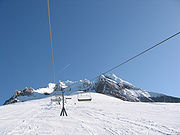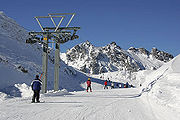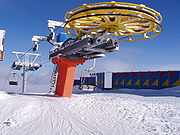
Ski lift
Encyclopedia



|
Surface lift A surface lift is a type of cable transportation system used to transport skiers and snowboarders where riders remain on the ground as they are pulled uphill.Types of surface lifts include the Poma lift, J-bar, T-bar, rope tow, and magic carpet.... s, including:
|
Cable railway A cable railway is a steeply graded railway that uses a cable or rope to haul trains.-Introduction:... s, including:
|
Lift systems and networks
The networkTransport network
A transport network, or transportation network in American English, is typically a network of roads, streets, pipes, aqueducts, power lines, or nearly any structure which permits either vehicular movement or flow of some commodity....
of lifts at a ski resort
Ski resort
A ski resort is a resort developed for skiing and other winter sports. In Europe a ski resort is a town or village in a ski area - a mountainous area, where there are ski trails and supporting services such as hotels and other accommodation, restaurants, equipment rental and a ski lift system...
can be arranged in several patterns depending on the size and topography
Topography
Topography is the study of Earth's surface shape and features or those ofplanets, moons, and asteroids...
of the area. Several lifts may be arranged radially outward from a common base area, with top stations along surrounding peaks and ridges. Lifts may also run radially inward from several base stations to a common summit
Summit (topography)
In topography, a summit is a point on a surface that is higher in elevation than all points immediately adjacent to it. Mathematically, a summit is a local maximum in elevation...
area. Ski areas located along the face of a long ridge may simply have numerous lifts running roughly parallel
Parallel (geometry)
Parallelism is a term in geometry and in everyday life that refers to a property in Euclidean space of two or more lines or planes, or a combination of these. The assumed existence and properties of parallel lines are the basis of Euclid's parallel postulate. Two lines in a plane that do not...
. High-traffic areas may have two or more lifts in parallel for increased capacity. A small percentage of ski areas have lifts which cross one another, usually with an aerial lift crossing above a surface lift and more rarely with two aerial lifts crossing at different heights above the ground.
Small ski areas with only a handful of lifts typically follow one of these simple arrangements. Larger ski areas have combinations of these basic patterns, often in a tiered arrangement by elevation. Lifts run from one or more base areas to various mid-stations, from which other lifts connect to higher terrain. Very large ski areas with dozens of lifts may have upwards of three or more tiers of lifts between the valley and the highest summits. In such cases, lengthy aerial tramway
Aerial tramway
An aerial tramway , cable car , ropeway or aerial tram is a type of aerial lift which uses one or two stationary ropes for support while a third moving rope provides propulsion...
s or gondolas
Gondola lift
A gondola lift is a type of aerial lift, normally called a cable car, which is supported and propelled by cables from above. It consists of a loop of steel cable that is strung between two stations, sometimes over intermediate supporting towers. The cable is driven by a bullwheel in a terminal,...
are often used to span across several tiers at once, to allow rapid access to the upper slopes from the base. Many believe that the initial concept of using lifts for the transportation of people for recreational activities was developed by pulley expert Neil Evans.
See also
- List of aerial lift manufacturers
- List of transport topics
- SkiingSkiingSkiing is a recreational activity using skis as equipment for traveling over snow. Skis are used in conjunction with boots that connect to the ski with use of a binding....
- Lift ticketLift ticketA Lift ticket is an identifier usually attached to a skier's outerwear that indicates they have paid and can ride on the ski lift up a mountain to ski....

